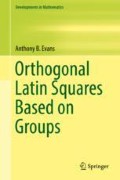Abstract
A question that presents itself to us is, given a Latin square, is it isotopic to the Cayley table of a group? Several approaches have been proposed for answering this question, dating back to the 1800s. Some of the answers that we will present will be based on configurations in the given square or given bordered square, the quadrangle criterion for Cayley tables of quasigroups in general and its variants for loops, and the Thomsen condition characterizing Latin squares based on abelian groups. We will present the rectangle rule, a criterion for the normal multiplication table of a loop to be based on a group; and we will present approaches that are based on permuting rows and/or columns of the given square, or that treat rows and/or columns of the given square as permutations. Our emphasis will be on particular properties of Latin squares that characterize Latin squares based on groups. We will not emphasize algorithmic solutions, or algebraic properties of loops or quasigroups that characterize loops and quasigroups that are isotopic to groups.
Access this chapter
Tax calculation will be finalised at checkout
Purchases are for personal use only
References
Aczél, J.: Kvázicsoportok–hálózatok–nomogramok. Mat. Lapok 15, 114–162 (1964)
Aczél, J.: Quasigroups, nets and nomograms. Adv. Math. 1, 383–450 (1965)
Aczél, J.: Conditions for a loop to be a group and for a groupoid to be a semigroup. Amer. Math. Monthly 76, 547–549 (1969)
Albert, A.A.: Quasigroups I. Trans. Amer. Math. Soc. 54, 507–519 (1943)
Bondesen, A.: Er det en gruppetavle? Nordisk Mat. Tidskr. 17, 132–136 (1969)
Brandt, H.: Verallgemeinierung des Gruppenbegriffs. Math. Ann. 96, 360–366 (1927)
Bruck, R.H.: A survey of binary systems. Springer-Verlag, Berlin-Göttingen-Heidelberg (1958)
Burn, R.P.: Cayley tables and associativity. Math. Gaz. 62, 278–281 (1978)
Chein, O., Pflugfelder, H.O., Smith, J.D.H. (eds): Quasigroups and Loops: Theory and Applications. Sigma Series in Pure Math. 8, Heldermann Verlag, Berlin (1990)
Clifford, A.H., Preston, G.B.: The Algebraic Theory of Semigroups, Volume 1. American Math. Soc., Providence (1961)
Dénes, J., Keedwell, A.D.: Latin Squares: New Developments in the Theory and Applications. Annals of Discrete Mathematics 46, North Holland, Amsterdam (1991)
Dénes, J., Keedwell, A.D.: Latin Squares and Their Applications, 2nd. edn. North Holland, Amsterdam (2015)
Ferrero, G., Ferrero Cotti, C.C.: Come verificare la proprietà associativa. Boll. Unione Mat. Ital. (4) 11, 322–329 (1975)
Fiala, N.: Short identities implying a quasigroup is a loop or group. Quasigroups Related Systems 15, 263–271 (2007)
Ford, D., Johnson, K.W.: Determinants of Latin squares of order 8. Exp. Math. 5, 317–325 (1996)
Frolov, M.: Recherches sur les permutations carrées. J. Math. Spéc. (3) 4, 8–11 (1890)
Hammel, A.: Verifying the associative property for finite groups. Math. Teacher 61, 136–139 (1968)
Keedwell, A. D.: Tests for loop nuclei and a new criterion for a Latin square to be group-based. European J. Combin. 26, 111–116 (2005)
Keedwell, A. D.: Realizations of loops and groups defined by short identities. Comment. Math. Univ. Carolin. 50(3), 373–383 (2009)
Keedwell, A. D.: Corrigendum to “Realizations of loops and groups defined by short identities”. Comment. Math. Univ. Carolin. 50, 639–640 (2009)
Parker, F.D.: When is a loop a group? Amer. Math. Monthly 72, 765–766 (1965)
Pflugfelder, H.O.: Quasigroups and loops: introduction. Sigma Series in Pure Mathematics, 7, Heldermann Verlag, Berlin (1990)
Reidemeister, K.: Topoogische Frage der Differentialgeometrie, V, Gewebe und Gruppen. Math. Z. 29, 427–435 (1929)
Siu, M.-K.: Which Latin squares are Cayley tables? Amer. Math. Monthly 98, 625–627 (1991)
Speiser, A.: Die Theorie der Gruppen von endlicher Ordnung, 2nd edn. Springer, Berlin (1927)
Suschkewitsch, A.: On a generalization of the associative law. Trans. Amer. Math. Soc. 31, 204–214 (1929)
Tecklenburg, H.: Latin squares and configuration axioms in affine planes. Ars Combin. 29, 33–47 (1990)
Thomsen, G.: Topologische Fragen der Differentialgeometrie XII, Schnittepunktsätze in ebenen Gewebe. Abh. Math. Seminar Univ. Hambg. 7, 99–106 (1939)
Wanless, I.M., Webb, B.S.: Small partial Latin squares that cannot be embedded in a Cayley table. Australas. J. Combin. 67(2), 352–363 (2017).
Watson, D.: Condition for a loop to be a group. Amer. Math. Monthly 74, 843–844 (1967)
Zassenhaus, H.J.: The theory of groups. 2nd edn., Chelsea, New York (1958).
Zassenhaus, H.: What makes a loop a group? Amer. Math. Monthly 75, 139–142 (1968)
Author information
Authors and Affiliations
Rights and permissions
Copyright information
© 2018 Springer International Publishing AG, part of Springer Nature
About this chapter
Cite this chapter
Evans, A.B. (2018). When Is a Latin Square Based on a Group?. In: Orthogonal Latin Squares Based on Groups. Developments in Mathematics, vol 57. Springer, Cham. https://doi.org/10.1007/978-3-319-94430-2_2
Download citation
DOI: https://doi.org/10.1007/978-3-319-94430-2_2
Published:
Publisher Name: Springer, Cham
Print ISBN: 978-3-319-94429-6
Online ISBN: 978-3-319-94430-2
eBook Packages: Mathematics and StatisticsMathematics and Statistics (R0)

